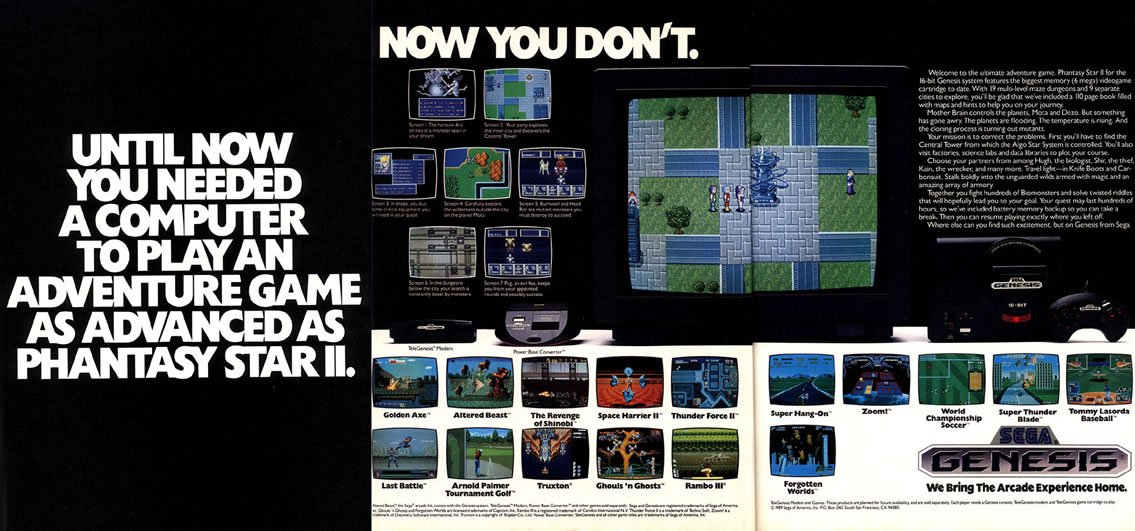Most of Mickey Mouse's 16-Bit endeavors have been held in high regard by fans, and it's relatively easy to see why. The challenges are tough but never overwhelming, the control is almost always tight, and the visuals have that distinct Disney charm to them, making them as fun to watch as they are to play. The first 16-Bit game on the iconic rodent's belt is Castle of Illusion, which came around during the "Genesis Does" campaign Sega was pushing so hard. Sega emphasized the animation of Mickey himself, while not being animated by Disney itself, looked incredibly slick for the time. Most Genesis fans agree that Castle of Illusion was the best game of the Genesis's second year.
The plot is this: Mickey and Minnie were spending time swinging each other around (for some odd reason), when all of a sudden, a rather hideous witch named Mizrabel kidnaps Minnie and takes her to the game's namesake setting; The Castle of Illusion. So now, Mickey has to find seven "rainbow gems" and destroy Mizrabel if he wants to get his girlfriend back.
Castle of Illusion plays like most side-scrolling platformers. Mickey can move left and right, jump, and throw "items" which are basically ammo. If you press the jump button when you are in the air Mickey will come down with a "butt slam" maneuver that can be used on your foes to launch you up higher. This move is quite novel and bouncing off multiple enemies is pretty satisfying.
The highlight of the game is definitely the visuals. While not exactly vibrant, they do have that Disney quality to them, and they are quite robust. The forest stage looks relatively dark and even the Dessert Palace looked kind of....gray. The enemies you face, as you probably expect, look like they have been pulled out of a Disney cartoon. Mickey himself is very well animated, and moves and jumps very fluidly. His facial expressions when he falls into a bottomless pit, or is about to fall over a edge, will more than likely bring a smile to your face.
The sound design gets the job done. The music sounds pretty good, some good tracks here and there. The boss theme sounds intense and menacing, and the Toy Palace theme is pretty catchy. The sound effects, however, are not very good. Mickey makes this high pitched shriek when he takes damage, and the 'shing' sound every time you destroy an enemy gets on your nerves.
I couldn't find any real major flaws with Castle of Illusion. It's a truly enjoyable little platform romp for the Genesis and is one of the games that helped Sega take the lead on the 16-Bit era. Almost everyone loves Mickey Mouse in some way, and this game certainly shows the rodent's charm. The Genesis didn't really take off until Sonic the Hedgehog in 1991, but Castle of Illusion definitely helped put Sega on top in the 16-Bit market.
PROS:
+ Great graphics for 1990.
+ Has that Disney charm.
+ Slick animation and fluid control.
+ Surprisingly intense and somber music.
CONS:
- Annoying sound effects.
OVERALL: 9 out of 10
The sound design gets the job done. The music sounds pretty good, some good tracks here and there. The boss theme sounds intense and menacing, and the Toy Palace theme is pretty catchy. The sound effects, however, are not very good. Mickey makes this high pitched shriek when he takes damage, and the 'shing' sound every time you destroy an enemy gets on your nerves.
I couldn't find any real major flaws with Castle of Illusion. It's a truly enjoyable little platform romp for the Genesis and is one of the games that helped Sega take the lead on the 16-Bit era. Almost everyone loves Mickey Mouse in some way, and this game certainly shows the rodent's charm. The Genesis didn't really take off until Sonic the Hedgehog in 1991, but Castle of Illusion definitely helped put Sega on top in the 16-Bit market.
PROS:
+ Great graphics for 1990.
+ Has that Disney charm.
+ Slick animation and fluid control.
+ Surprisingly intense and somber music.
CONS:
- Annoying sound effects.
OVERALL: 9 out of 10



